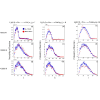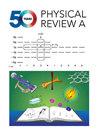跨同位素原子-原子反应的机器学习模型
IF 2.9
2区 物理与天体物理
Q2 Physics and Astronomy
引用次数: 0
摘要
这项研究表明,前馈神经网络可以预测超热状态下 Ca+H2→CaH+H 反应的非弹性和反应过程的最终振荡状态分布,这与缓冲气体化学有关。此外,这些模型还可扩展到涉及氘和氚反应的同位素。此外,我们还开发了一种神经网络模型,可以根据氢的同位素在化学空间中进行学习。该模型可以预测反应物从未见过的反应结果。具体方法是对 Ca+H2 和 Ca+T2 反应进行训练,然后预测 Ca+D2 反应。本文章由计算机程序翻译,如有差异,请以英文原文为准。

Machine-learning models for atom-diatom reactions across isotopologues
This work shows that feed-forward neural networks can predict the final rovibrational state distributions of inelastic and reactive processes of the reaction of in the hyperthermal regime, relevant for buffer gas chemistry. Furthermore, these models can be extended to the isotopologues of the reaction involving deuterium and tritium. In addition, we develop a neural network model that can learn across the chemical space based on the isotopologues of hydrogen. The model can predict the outcome of a reaction whose reactants have never been seen. This is done by training on the and reactions and subsequently predicting the reaction.
求助全文
通过发布文献求助,成功后即可免费获取论文全文。
去求助
来源期刊

Physical Review A
物理-光学
CiteScore
5.40
自引率
24.10%
发文量
0
审稿时长
2.2 months
期刊介绍:
Physical Review A (PRA) publishes important developments in the rapidly evolving areas of atomic, molecular, and optical (AMO) physics, quantum information, and related fundamental concepts.
PRA covers atomic, molecular, and optical physics, foundations of quantum mechanics, and quantum information, including:
-Fundamental concepts
-Quantum information
-Atomic and molecular structure and dynamics; high-precision measurement
-Atomic and molecular collisions and interactions
-Atomic and molecular processes in external fields, including interactions with strong fields and short pulses
-Matter waves and collective properties of cold atoms and molecules
-Quantum optics, physics of lasers, nonlinear optics, and classical optics
 求助内容:
求助内容: 应助结果提醒方式:
应助结果提醒方式:


